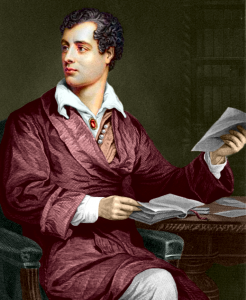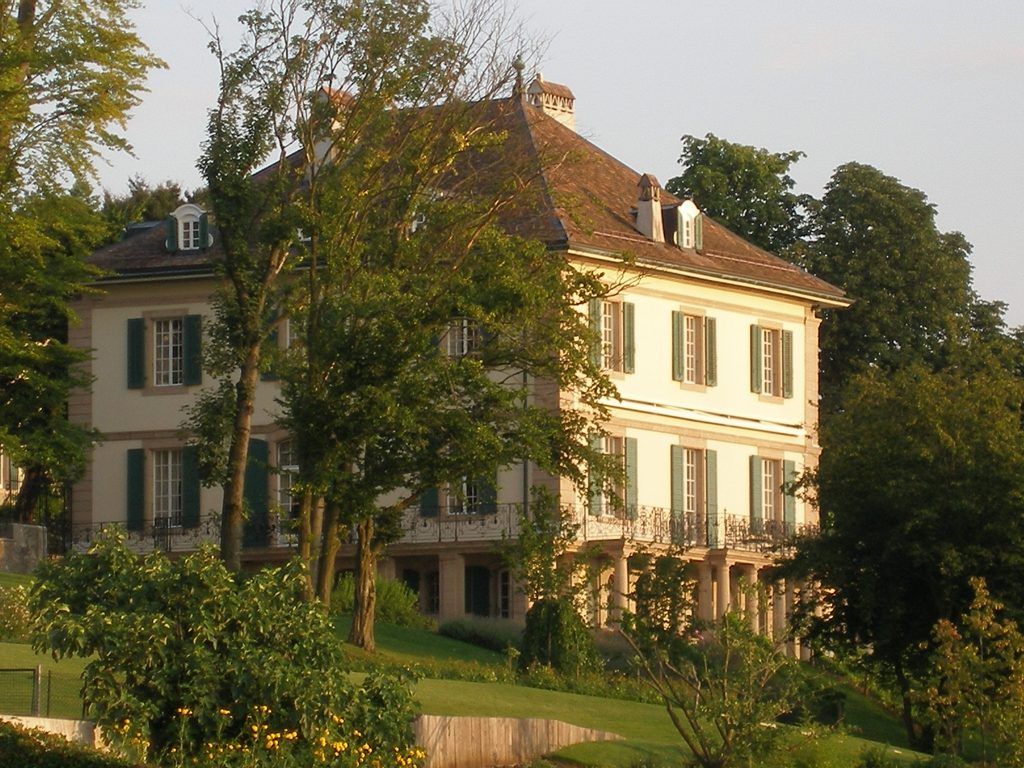![Byron as depicted in a BBC Documentary about Byron and the Shelleys [PHOTO: bbc.co.uk]](https://historythings.com/wp-content/uploads/2016/10/p029810n.jpg)
Byron as depicted in a BBC Documentary about Byron and the Shelleys, Frankenstein and the Vampyre [PHOTO: bbc.co.uk].
Lord Byron is considered one of the most influential poets of the Romantic period. While he’s known for some of the most beautiful poetry about nature and angsty poetry about love, he was also a little kooky. His life was characterized by love affairs, strange habits, and a love of all things dark and mysterious.
Early Life

PHOTO: susannahfullerton.com
George Gordon Byron was born on January 22, 1788 to an aristocratic family in England. His father abandoned their family at a young age and eventually cut his own throat. His mother suffered violent schizophrenic episodes and left the young Byron to an abusive nurse.
At the tender age of 10, in 1798, George Byron became a young lord. When he was twelve, he was sent to Harrow School in London. While there, he began experimenting with his sexuality, engaging in relationships with both young men and young women.
In 1803, he had his first big romance. He met his distant cousin, Mary Chaworth, and fell passionately in love. Unfortunately for Byron, Mary didn’t feel the same. Fueled by the pain of teenage angst and unrequited love, Byron wrote the first of his poems, “Hills of Annesley” and “The Adieu”.
When he was fifteen, he attended Trinity College and spent his time falling in and out of love, gambling, spending money on his lovers, and falling into a deep pit of debt. He had a long affair with his half-sister, and several relationships with married women, young men, and actresses. He had so many dangerous sexual relationships that, by the time he was twenty-one, he had both gonorrhea and syphilis.
He had a great love of animals, and, when he was a student, he even tried to get a tame bear enrolled as a student so he could keep it with him in his room. Despite the rules at his college, he kept the bear with him, and even enjoyed taking it for walks around campus just to get a reaction out of people walking by.
Early Career and Eccentricities
Byron published his first volume of poetry, Hours of Idleness, in 1808. It was received so poorly and had such terrible reviews that Byron, insulted, wrote a satirical poem called “English Bards and Scotch Reviewers”, that actually ended up gaining him real literary fame.
In the following years, Byron traveled all across the world, visiting Spain, Portugal, Malta, Albania, Greece, and Turkey. When his mother died in 1811, Byron was forced to return home to London and finally take responsibility and return to his family home of Newstead Abbey. It was here that he holed up, had his serial affairs, and wrote most of his famous poetry.
![Newstead Abbey [PHOTO: theculturetrip.com]](https://historythings.com/wp-content/uploads/2016/10/b3-650x488.jpg)
Newstead Abbey [PHOTO: theculturetrip.com]
Byron had a flair for the Gothic aesthetic, a flair that was well furnished in the supposedly haunted Byron family home. He set up a coffin at one end of his dining room, and pulled skulls from the family crypt and nearby monastery graveyard to be polished and used them as flowerpots and drinking goblets. According to his friends, he loved to dress all in black. He even reportedly hated sunlight, and would hang up dark curtains to keep his home wonderfully dreary, setting the mood for his angsty poems about love, passion, guilt, and heartbreak.
By 1814, Byron had had so many affairs that he proposed to Anne Isabella Milbanke in order to have an excuse to get away from his lovers and mistresses. In January of 1815, they married, and by December Lord Byron’s only legitimate child, Ada Lovelace, was born.
The marriage lasted only a year. Byron was a heavy drinker, crash dieter, and careless gambler. During the marriage, he had still been involved with his half sister, and to make matters worse, his wife also didn’t approve of his bisexuality. In January of 1816, Anne took Ada and left Byron to his own devices. He would never see his wife or daughter again.
Exile
Desperate to flee the responsibilities of his mounting debt and the wave of heartbreak, distress, and conflict brought on by his numerous affairs, Lord Byron left England for good. He traveled to Switzerland. There, he met Percy Shelley, and his wife Mary Shelley – the self-same creator of the famous novel, Frankenstein.

The house on Lake Geneva [PHOTO: wikimedia].
In October of 1816, Byron and his friend, John Hobhouse, traveled to Italy. Two years later, when Byron was thirty, he met a 19-year-old, married countess by the name of Teresa Guiccioli. The two, predictably, fell madly in love and had a passionate, romantic relationship that resulted in Teresa leaving her husband for Byron.
Death
Byron worked on his poetry up until his death. He was still having affairs, and still madly in love with Teresa, but curiously restless.
It came as no surprise when, in 1823, Byron jumped at a chance for one last adventure: he would help Greece win independence from the Ottoman Empire. He spent 4,000 pounds to help rebuild the Greek fleet, and fulfilled a childhood dream of becoming a naval officer by taking command of his own Greek unit.
However, the excitement proved too much for him. The diseases that he’d procured over the years had significantly weakened the young poet. On February 15th, 1824, he fell deathly ill. Misinformed doctors decided to drain his blood in order to try and let out the ‘bad blood’ in him. This only worsened his illness.

PHOTO: flickr.com
On April 19th 1824, Lord Byron died at the age of 36. All of England mourned his death, but because of his lifestyle, the Church refused to bury him at Westminster Abbey. Byron was buried in the family crypts at the Byron family seat in Newstead.
In 1969, a monument to the poet was put in Westminster Abbey.
It’s been speculated that The Vampyre, a story written by Lord Byron’s doctor, was inspired by Byron himself. The fictional Lord Ruthren, with his brooding face, icy eyes, and love for all things Gothic sounds a lot like our poet.
If so, then Byron was not only one of the leading writers of the Romantic period, but also the inspiration behind many popular archetypes of chilling vampires we see today in fiction. For such a flamboyant, brooding, purposefully mysterious and gloomy man, it seems rather appropriate, don’t you think?

